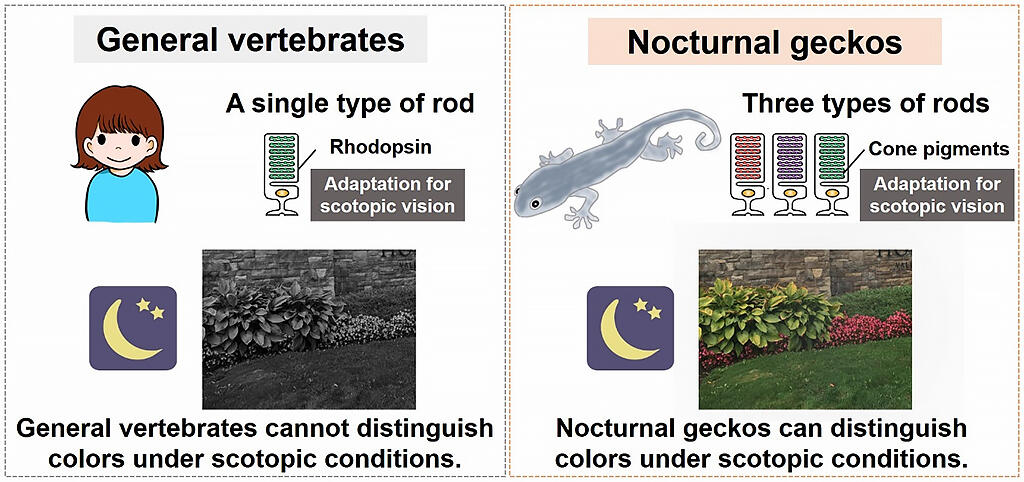A research group comprising Lecturer Takahiro Yamashita and Professor Emeritus Yoshinori Shichida of the Graduate School of Science, Kyoto University and Assistant Professor Keiichi Kojima of the Graduate School of Medicine, Dentistry and Pharmaceutical Sciences, Okayama University clarified the mechanism through which nocturnal geckos distinguish between different colors in the dark.
The retina of the vertebrate eye contains two types of visual cells, rods and cones, which are responsible for scotopic and photopic vision respectively. Both photoreceptor cells contain visual pigments that are proteins that specially function to receive light (photosensor proteins). The visual pigment in rods is called rhodopsin. Photosensor proteins are important for responses to light. However, in rare cases, these proteins incorrectly generate a response even in the absence of light.
Erroneous responses (noise) that occur in the absence of light can interfere with vision in the dark; this is because a small amount of light is sensitively recognized. Rhodopsin is known to enable vision in the dark by maintaining a very low noise response. When an object is viewed in a well-lit space, the sensitivity to light must be reduced as strong light intensity enters the eye. The cone visual material is known to exhibit a high noise reaction and play a role in vision in lit spaces.
The research group assessed the nature of the cone visual material that functions in the rods of nocturnal geckos. They found that these materials are not reactive in the presence of light, but are erroneously reactive in its absence. This cone pigment that functions in the rods of nocturnal geckos suppresses the noise reaction to levels as low as those of rhodopsin by undergoing substitution in several of its amino acids. This pigment also has properties suitable for vision in the dark. Nocturnal geckos adapted the nature of their photosensor proteins that were primarily responsible for vision in the presence of light to those suitable for vision in the dark (scotopic conditions).

Credit: Kyoto University
Geckos in Japan are typically nocturnal. However, diurnal geckos inhabit the tropics, such as Madagascar. These geckos are called "day geckos" and are thought to have evolved independently from nocturnal geckos. The eyes of diurnal geckos contain only three types of cones and possess cone visual substances that absorb red, green, and purple light. The properties of the cone visual material in diurnal geckos were examined, and were found to have high noise responses and suitable properties for vision in the presence of light. This finding suggested that diurnal geckos adapted the nature of their photosensor proteins to light vision during their evolution from nocturnal geckos. The diurnal gecko is thought to regain color vision in well-lit spaces by utilizing three types of cones. Geckos uniquely change their ability to see color according to the rhythm of their life and recognize their surroundings using color during the times they are active, when it is useful for them.
Dr. Yamashita said, "Many animals in nature change their life patterns in various light environments. We wish to clarify the properties of photosensor proteins of these animals. By doing so, we hope to understand at the molecular level how skillfully animals adapt to their habitats."
This article has been translated by JST with permission from The Science News Ltd.(https://sci-news.co.jp/). Unauthorized reproduction of the article and photographs is prohibited.




